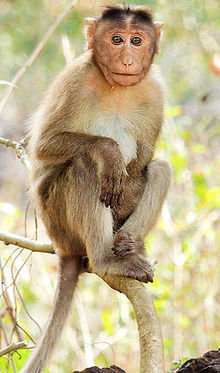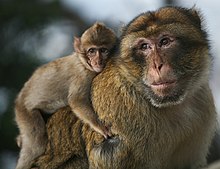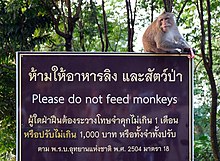
A | B | C | D | E | F | G | H | CH | I | J | K | L | M | N | O | P | Q | R | S | T | U | V | W | X | Y | Z | 0 | 1 | 2 | 3 | 4 | 5 | 6 | 7 | 8 | 9
| Monkeys Temporal range:
| |
|---|---|

| |
| Bonnet macaque Macaca radiata Mangaon, Maharashtra, India | |
| Scientific classification | |
| Domain: | Eukaryota |
| Kingdom: | Animalia |
| Phylum: | Chordata |
| Class: | Mammalia |
| Order: | Primates |
| Suborder: | Haplorhini |
| Infraorder: | Simiiformes [a] |
| Groups included | |
| Cladistically included but traditionally excluded taxa | |
Monkey is a common name that may refer to most mammals of the infraorder Simiiformes, also known as the simians. Traditionally, all animals in the group now known as simians are counted as monkeys except the apes. Thus monkeys, in that sense, constitute an incomplete paraphyletic grouping; however, in the broader sense based on cladistics, apes (Hominoidea) are also included, making the terms monkeys and simians synonyms in regard to their scope.
In 1812, Étienne Geoffroy grouped the apes and the Cercopithecidae group of monkeys together and established the name Catarrhini, "Old World monkeys", ("singes de l'Ancien Monde" in French).[3][4][5] The extant sister of the Catarrhini in the monkey ("singes") group is the Platyrrhini (New World monkeys).[3] Some nine million years before the divergence between the Cercopithecidae and the apes,[6] the Platyrrhini emerged within "monkeys" by migration to South America from Afro-Arabia (the Old World),[citation needed][7][8] likely by ocean.[9][10][better source needed] Apes are thus deep in the tree of extant and extinct monkeys, and any of the apes is distinctly closer related to the Cercopithecidae than the Platyrrhini are.
Many monkey species are tree-dwelling (arboreal), although there are species that live primarily on the ground, such as baboons. Most species are mainly active during the day (diurnal). Monkeys are generally considered to be intelligent, especially the Old World monkeys.
Within suborder Haplorhini, the simians are a sister group to the tarsiers – the two members diverged some 70 million years ago.[11] New World monkeys and catarrhine monkeys emerged within the simians roughly 35 million years ago. Old World monkeys and apes emerged within the catarrhine monkeys about 25 million years ago. Extinct basal simians such as Aegyptopithecus or Parapithecus (35–32 million years ago) are also considered monkeys by primatologists.[12][9][13][14][15][16]
Lemurs, lorises, and galagos are not monkeys, but strepsirrhine primates (suborder Strepsirrhini). The simians' sister group, the tarsiers, are also haplorhine primates; however, they are also not monkeys.[citation needed]
Apes emerged within monkeys as sister of the Cercopithecidae in the Catarrhini, so cladistically they are monkeys as well. However, there has been resistance to directly designate apes (and thus humans) as monkeys, so "Old World monkey" may be taken to mean either the Cercopithecoidea (not including apes) or the Catarrhini (including apes).[17][18][19][20][21][22][23][24][25] That apes are monkeys was already realized by Georges-Louis Leclerc, Comte de Buffon in the 18th century.[26] Linnaeus placed this group in 1758 together with the tarsiers, in a single genus "Simia" (sans Homo), an ensemble now recognised as the Haplorhini.[27]
Monkeys, including apes, can be distinguished from other primates by having only two pectoral nipples, a pendulous penis, and a lack of sensory whiskers.[28][better source needed]
Historical and modern terminology

According to the Online Etymology Dictionary, the word "monkey" may originate in a German version of the Reynard the Fox fable, published c. 1580. In this version of the fable, a character named Moneke is the son of Martin the Ape.[29] In English, no clear distinction was originally made between "ape" and "monkey"; thus the 1911 Encyclopædia Britannica entry for "ape" notes that it is either a synonym for "monkey" or is used to mean a tailless humanlike primate.[30] Colloquially, the terms "monkey" and "ape" are widely used interchangeably.[31][32] Also, a few monkey species have the word "ape" in their common name, such as the Barbary ape.
Later in the first half of the 20th century, the idea developed that there were trends in primate evolution and that the living members of the order could be arranged in a series, leading through "monkeys" and "apes" to humans.[33] Monkeys thus constituted a "grade" on the path to humans and were distinguished from "apes".
Scientific classifications are now more often based on monophyletic groups, that is groups consisting of all the descendants of a common ancestor. The New World monkeys and the Old World monkeys are each monophyletic groups, but their combination was not, since it excluded hominoids (apes and humans). Thus, the term "monkey" no longer referred to a recognized scientific taxon. The smallest accepted taxon which contains all the monkeys is the infraorder Simiiformes, or simians. However this also contains the hominoids, so that monkeys are, in terms of currently recognized taxa, non-hominoid simians. Colloquially and pop-culturally, the term is ambiguous and sometimes monkey includes non-human hominoids.[34] In addition, frequent arguments are made for a monophyletic usage of the word "monkey" from the perspective that usage should reflect cladistics.[21][35][36][37][38]
Several science-fiction and fantasy stories have depicted non-human (fantastical or alien) antagonistic characters refer to humans as monkeys, usually in a derogatory manner, as a form of metacommentary.[39]
A group of monkeys may be commonly referred to as a tribe or a troop.[40]
Two separate groups of primates are referred to as "monkeys": New World monkeys (platyrrhines) from South and Central America and Old World monkeys (catarrhines in the superfamily Cercopithecoidea) from Africa and Asia. Apes (hominoids)—consisting of gibbons, orangutans, gorillas, chimpanzees and bonobos, and humans—are also catarrhines but were classically distinguished from monkeys.[41][9][42][43] Tailless monkeys may be called "apes", incorrectly according to modern usage; thus the tailless Barbary macaque is historically called the "Barbary ape".[32]
Description
As apes have emerged in the monkey group as sister of the old world monkeys, characteristics that describe monkeys are generally shared by apes as well. Williams et al. outlined evolutionary features, including in stem groupings, contrasted against the other primates such as the tarsiers and the lemuriformes.[44]
Monkeys range in size from the pygmy marmoset, which can be as small as 117 mm (4+5⁄8 in) with a 172 mm (6+3⁄4 in) tail and just over 100 g (3+1⁄2 oz) in weight,[45] to the male mandrill, almost 1 m (3 ft 3 in) long and weighing up to 36 kg (79 lb).[46] Some are arboreal (living in trees) while others live on the savanna; diets differ among the various species but may contain any of the following: fruit, leaves, seeds, nuts, flowers, eggs and small animals (including insects and spiders).[47]
Some characteristics are shared among the groups; most New World monkeys have long tails, with those in the Atelidae family being prehensile, while Old World monkeys have non-prehensile tails or no visible tail at all.[32] Old World monkeys have trichromatic color vision like that of humans, while New World monkeys may be trichromatic, dichromatic, or—as in the owl monkeys and greater galagos—monochromatic. Although both the New and Old World monkeys, like the apes, have forward-facing eyes, the faces of Old World and New World monkeys look very different, though again, each group shares some features such as the types of noses, cheeks and rumps.[47]
Classification
The following list shows where the various monkey families (bolded) are placed in the classification of living (extant) primates.
- Order Primates
- Suborder Strepsirrhini: lemurs, lorises, and galagos
- Suborder Haplorhini: tarsiers, monkeys, and apes
- Infraorder Tarsiiformes
- Family Tarsiidae: tarsiers
- Infraorder Simiiformes: simians
- Parvorder Platyrrhini: New World monkeys
- Family Callitrichidae: marmosets and tamarins (42 species)
- Family Cebidae: capuchins and squirrel monkeys (14 species)
- Family Aotidae: night monkeys (11 species)
- Family Pitheciidae: titis, sakis, and uakaris (41 species)
- Family Atelidae: howler, spider, and woolly monkeys (24 species)
- Parvorder Catarrhini
- Superfamily Cercopithecoidea
- Family Cercopithecidae: Old World monkeys (135 species)
- Superfamily Hominoidea: apes
- Family Hylobatidae: gibbons ("lesser apes") (20 species)
- Family Hominidae: great apes (including humans, gorillas, chimpanzees, and orangutans) (8 species)
- Superfamily Cercopithecoidea
- Parvorder Platyrrhini: New World monkeys
- Infraorder Tarsiiformes
Cladogram with extinct families
Below is a cladogram with some extinct monkey families.[48][49][50] Generally, extinct non-hominoid simians, including early catarrhines are discussed as monkeys as well as simians or anthropoids,[41][9][42] which cladistically means that Hominoidea are monkeys as well, restoring monkeys as a single grouping. It is indicated approximately how many million years ago (Mya) the clades diverged into newer clades.[51][52][53][54] It is thought the New World monkeys started as a drifted "Old World monkey" group from the Old World (probably Africa) to the New World (South America).[9]
| Haplorhini (64) |
| ||||||||||||||||||||||||||||||||||||||||||||||||||||||||||||||||||||||||||||||||||||||||||||||||||||||||||||||||||||||||||||||||||||||||||
Relationship with humans


The many species of monkey have varied relationships with humans. Some are kept as pets, others used as model organisms in laboratories or in space missions. They may be killed in monkey drives (when they threaten agriculture) or used as service animals for the disabled.
In some areas, some species of monkey are considered agricultural pests, and can cause extensive damage to commercial and subsistence crops.[55][56] This can have important implications for the conservation of endangered species, which may be subject to persecution. In some instances farmers' perceptions of the damage may exceed the actual damage.[57] Monkeys that have become habituated to human presence in tourist locations may also be considered pests, attacking tourists.[58]
Public exhibition
Zdroj:https://en.wikipedia.org?pojem=MonkeyText je dostupný za podmienok Creative Commons Attribution/Share-Alike License 3.0 Unported; prípadne za ďalších podmienok. Podrobnejšie informácie nájdete na stránke Podmienky použitia.
Antropológia
Aplikované vedy
Bibliometria
Dejiny vedy
Encyklopédie
Filozofia vedy
Forenzné vedy
Humanitné vedy
Knižničná veda
Kryogenika
Kryptológia
Kulturológia
Literárna veda
Medzidisciplinárne oblasti
Metódy kvantitatívnej analýzy
Metavedy
Metodika
Text je dostupný za podmienok Creative
Commons Attribution/Share-Alike License 3.0 Unported; prípadne za ďalších
podmienok.
Podrobnejšie informácie nájdete na stránke Podmienky
použitia.
www.astronomia.sk | www.biologia.sk | www.botanika.sk | www.dejiny.sk | www.economy.sk | www.elektrotechnika.sk | www.estetika.sk | www.farmakologia.sk | www.filozofia.sk | Fyzika | www.futurologia.sk | www.genetika.sk | www.chemia.sk | www.lingvistika.sk | www.politologia.sk | www.psychologia.sk | www.sexuologia.sk | www.sociologia.sk | www.veda.sk I www.zoologia.sk
